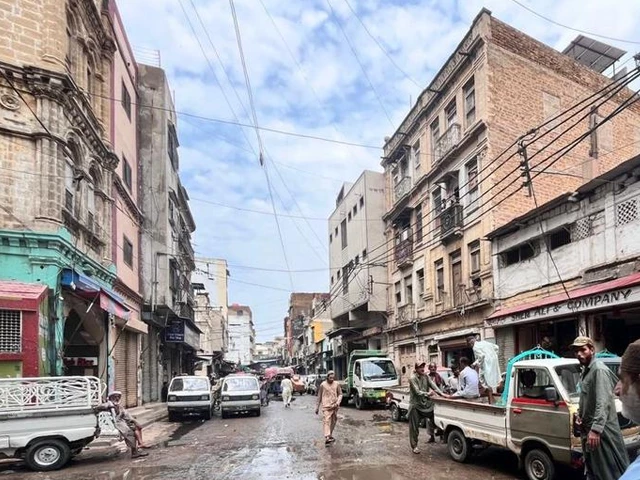Power outages continued to torment Karachiites on Friday, hours after record-breaking monsoon rains battered the city, leaving several neighborhoods and apartment substations without electricity.
Water seeping into underground cables has led to prolonged power cuts in different parts of the city, with some areas without power for four consecutive days.
Electricity remained cut off for long hours in several neighborhoods, including Moinabad, Surjani Town, Yousuf Goth, Safora Goth, Kaneez Fatima Society, Madras Chowk, Nauman Square, Scheme 33, Baldia, parts of Defence Housing Authority, Gulistan-e-Jauhar Block 10, Bin Qasim, Gulshan-e-Hadeed, Manghopir, Razzaqabad, Urdu Bazaar area, and MA Jinnah Road.
Residents of several areas are also facing water shortages as a consequence of prolonged power failures.
A spokesperson for K-Electric told The Express Tribune that restoration work is underway. “Power has been restored in most areas. Out of 2,100 feeders, only 40 remain down as of now due to waterlogging,” said the spokesperson.
Citizens blocked roads and staged demonstrations outside the power utility’s offices on University Road, Tipu Sultan Road, Malir, and Liaquat Market, demanding immediate restoration of power.
In Malir, the blockage on the Mehran Depot route disrupted the People’s Bus Service’s operations, while protests on Jinnah Avenue and its surrounding areas caused major traffic disruptions.
Sindh Energy Minister Syed Nasir Hussain Shah made a surprise visit to K-Electric’s headquarters on Thursday, directing officials to address public grievances on an urgent basis.
Schools and colleges reopened on Friday after three days of disruption to routine life caused by record-breaking monsoon rains. With light rain expected today, the Sindh government did not notify a public holiday today.
Despite the forecast for heavy showers and thunderstorms yesterday, the day remained largely sunny with light to moderate showers in different parts of the city in the evening.
Read: Scattered showers hit Karachi amid ongoing power outages
Educational institutions had remained closed on Wednesday and Thursday following torrential downpours that submerged large parts of the city and triggered widespread urban flooding.
According to the Pakistan Meteorological Department (PMD), Karachi received more than 200 millimeters of rainfall between Tuesday and Thursday, overwhelming the city’s fragile drainage system and causing severe disruption.
نوکاسٹنگ اپ ڈیٹ – 2
تاریخ: 21/08/2025
وقت: 7:47 شامموجودہ صورتحال کے مطابق تیز رفتار گرج چمک کے بادلوں کا ایک طاقتور کلسٹر اس وقت کراچی کے مشرق، جنوب مشرق اور شمال مشرق میں موجود ہے اور بتدریج شہر کی طرف بڑھ رہا ہے۔ اس وقت شہر کے بیشتر حصوں میں ہلکی سے درمیانی شدت کی بارش pic.twitter.com/JkIMfBiTCK
— Weather Updates PK (@WeatherWupk) August 21, 2025
Heavy showers led to urban flooding in key areas, caused damage to the city’s infrastructure and prolonged traffic jams.
System weakens
The Met Office has since reported that the monsoon system over Karachi has weakened, with only light drizzle and showers expected in the coming days. A fresh spell of rain is forecast to begin from August 27.
The heavy downpour earlier this week led to submerged roads and underpasses, paralysing movement and causing both financial and human losses. PMD Karachi spokesperson Anjum Nazir Zigham confirmed that the latest advisory issued on August 21 was for upper regions of the country and no major downpour is immediately forecast for the metropolis.
In response to the civic breakdown, Pakistan Peoples Party (PPP) leader Shazia Marri defended the provincial government’s handling of the crisis, stating that “no party can control or change the weather”.
She stressed that preparations had been made in advance, including drain cleaning and repair work, and credited the city administration for preventing a worse disaster.
Marri added that President Asif Ali Zardari and PPP Co-chairperson Bilawal Bhutto-Zardari remained in constant contact with officials during the rains and Sindh Chief Minister Murad Ali Shah personally monitored water drainage in affected areas.
Read more: Karachi reels from torrential rains
Mayor Murtaza Wahab stated on social media that rainwater had been cleared quickly from major roads, adding that the city administration had mobilised all available resources to mitigate the impact of the monsoon. He credited early drain-cleaning and preparedness measures for preventing a larger crisis.
Despite incessant rain, KMC roads are clear and traffic is moving. Would urge people not to move unnecessarily especially request bike users to be extremely careful. People going towards Malir & Airport should preferably use Shahrah e Bhutto. Even the side of Shah Faisal Colony… pic.twitter.com/qrXnPW6dwu
— Murtaza Wahab Siddiqui (@murtazawahab1) August 21, 2025
Over the week, least a dozen deaths were reported across the city from rain-related incidents, including electrocutions and drowning.
Urban flooding had left underpasses, main roads, and residential colonies inundated. Commercial activity and transport were severely disrupted.
The National Disaster Management Authority had earlier cautioned that rainfall levels exceeding 160 millimeters could overwhelm urban infrastructure.
Although the situation has stabilised with traffic returning to the streets, the city continues to face lingering challenges of electricity restoration and damaged civic infrastructure.

